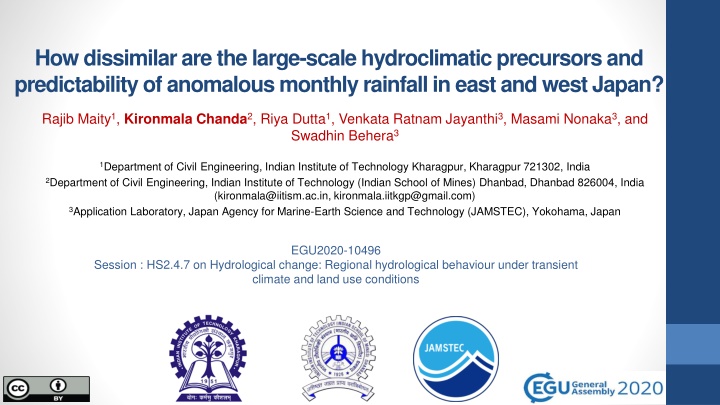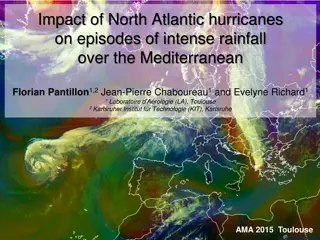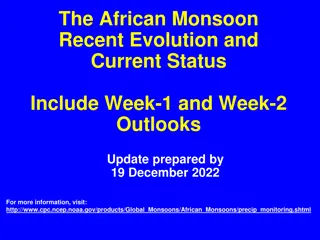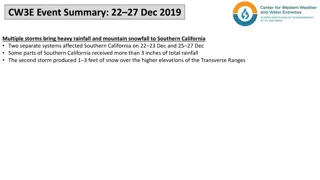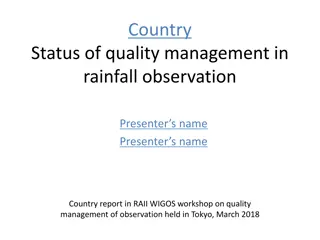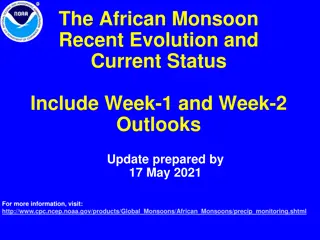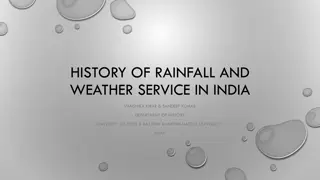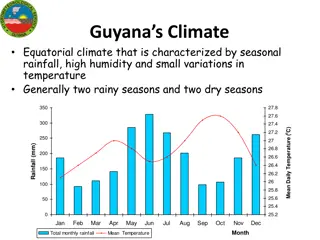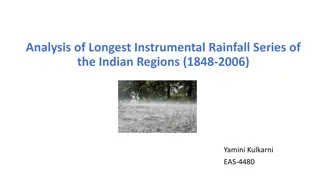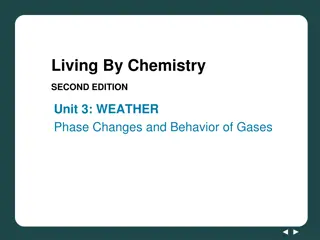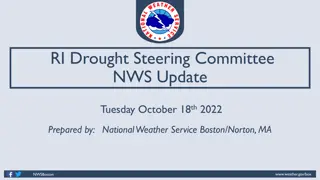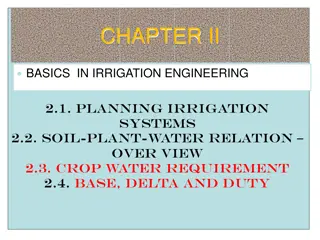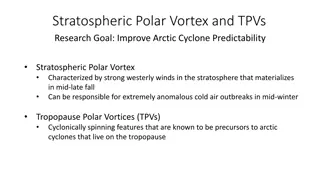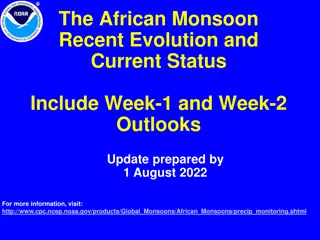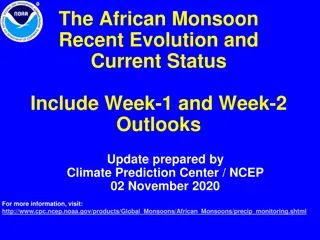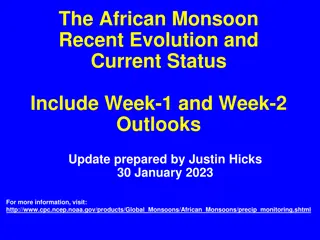Hydroclimatic Precursors and Rainfall Predictability in East and West Japan
Variability of rainfall in Japan is influenced by Pacific and Indian Ocean teleconnections. Understanding the hydroclimatic precursors in East and West Japan is crucial for seasonal rainfall prediction. This study compares different methodologies to extract teleconnection features and develop models for predicting monthly rainfall in the two regions, considering the distinct rainfall patterns in summer and winter.
Download Presentation

Please find below an Image/Link to download the presentation.
The content on the website is provided AS IS for your information and personal use only. It may not be sold, licensed, or shared on other websites without obtaining consent from the author.If you encounter any issues during the download, it is possible that the publisher has removed the file from their server.
You are allowed to download the files provided on this website for personal or commercial use, subject to the condition that they are used lawfully. All files are the property of their respective owners.
The content on the website is provided AS IS for your information and personal use only. It may not be sold, licensed, or shared on other websites without obtaining consent from the author.
E N D
Presentation Transcript
How dissimilar are the large-scale hydroclimaticprecursors and predictability of anomalous monthly rainfall in east and west Japan? Rajib Maity1, Kironmala Chanda2, Riya Dutta1, Venkata Ratnam Jayanthi3, Masami Nonaka3, and Swadhin Behera3 1Department of Civil Engineering, Indian Institute of Technology Kharagpur, Kharagpur 721302, India 2Department of Civil Engineering, Indian Institute of Technology (Indian School of Mines) Dhanbad, Dhanbad 826004, India (kironmala@iitism.ac.in, kironmala.iitkgp@gmail.com) 3Application Laboratory, Japan Agency for Marine-Earth Science and Technology (JAMSTEC), Yokohama, Japan EGU2020-10496 Session : HS2.4.7 on Hydrological change: Regional hydrological behaviour under transient climate and land use conditions
Background & Motivation Variability of rainfall over Japan, is linked to Sea Surface Temperature (SST) anomalies in the Pacific through Pacific-Japan (PJ) and East Asia-Pacific (EAP) teleconnections (Feng and Hu, 2004; Huang, 2004; Ha et al., 2012; Zhang et al., 2014; Wu et al. 2016; Li, 2018) Indian Ocean Dipole (IOD) is also known to affect the rainfall variability over Japan (Saji and Yamagata, 2003) Below- and above-normal rainfall events over east and west Japan are not always concurrent, neither are their causal agents identical Furthermore, rainfall patterns in the two seasons, June to August (summer) and December to February (winter) are quite distinct Inter- and intra-seasonal rainfall variations in EJ and WJ require an individual assessment of hydroclimatic teleconnection 2
Objective & methodological approach To extract the hydroclimatic teleconnection features from global SST fields that influence inter-seasonal and intra- seasonal rainfall variability in EJ and WJ For this, we use the concept of Global Climate Pattern (GCP) (Chanda and Maity, 2015) To utilize the hydroclimatic teleconnection information for the development of a model for the season-wise prediction of monthly rainfall for EJ and WJ For this, we compare 2 approaches: 1. Hybrid GM-Copula approach (Dutta and Maity, 2018) 2. Machine Learning approach, namely Support Vector Regression (SRV). 3
Study Area and Data Climate is different over east and west Japan (JMA: http://www.data.jma.go.jp/gmd/cpd/longfcst/ en/ tourist.html) Precipitation pattern is different on the east and west of 138 E (Ohba et al., 2015) Spatial Resolution Name of the variable Source Period Sea Surface Temperature (SST) ( C) National Oceanic and Atmospheric Administration (NOAA) Extended Reconstructed V5 2 lat x 2 lon 1979- 2015 4 Asian Precipitation - Highly-Resolved Observational Data Integration Towards Evaluation of Water Resources (APHRODITE) (Yatagai et al. 2012) Aggregated over EJ and WJ Rainfall 1979-2015
Global SST patterns for monthly rainfall in West Japan (WJ) SUMMER WINTER DEC JUN JAN JUL FEB AUG 5
Selected SST zones for west Japan Season Month Symbol Lag (months) Latitude Longitude results 1 1 1 2 1 2 2 1 1 2 1 1 2 1 1 1 1 2 2 0 to 20 N 180 to 140 W 25 N to 35 N 15 S to 5 S 15 S to 5 N 5 N to 15 N 5 N to 20 N 25 S to 15 S 0 to 15 N 115 E to 145 E 40 S to 30 S 35 N to 45 N 5 S to 5 N 45 S to 35 S -5 S to 10 N 15 S to 0 35 S to 25 S -15 S to 10 S 35 N to 45 N 0 to 20 N 115 E to 125 E 30 S to 20 S SST1 SST2 SST3 SST4 SST1 SST2 SST3 SST1 SST2 SST3 SST1 SST2 SST3 SST1 SST2 SST3 SST1 SST2 SST3 145 E to 180 145 W to 130 W 85 E to 115 E 100 E to 125 E 135 E to 155 E 80 E to 110 E Jun Summer Jul Aug 75 E to 95 E 160 E to 170 E 170 E to 170 W 80 E to 100 E 95 E to 135 E 45 E to 85 E 45 E to 85 E 180 to 160 W 150 W to 140 W Dec Jan Winter 6 Feb 105 W to 85 W Input variables further selected via the GM-Copula approach are in boldface
Global SST patterns for monthly rainfall in East Japan (EJ) SUMMER WINTER DEC JUN JAN JUL FEB AUG 7
Selected SST zones for east Japan Season Month Symbol SST1 SST2 SST3 SST4 SST5 SST6 SST7 SST8 SST9 SST1 SST2 SST3 SST4 SST5 SST1 SST2 SST3 SST4 SST1 SST2 SST3 SST4 SST5 SST1 SST2 SST1 SST2 SST3 SST4 Lag (months) 1 1 1 1 1 1 1 1 2 1 1 1 1 1 1 1 1 2 1 1 1 1 2 1 2 1 1 1 2 Latitude Longitude results 0 to 15 N 15 S to 0 30 S to 15 S 75 S to 45 S 15 S to 0 30 N to 40 N 45 N to 65 N 40 S to 25 S 5 N to 15 N 0 to 15 N 5 S to 5 N 55 S to 35 S 10 N to 30 N 40 S to 20 S 15 N to 30 N 10 N to 20 N 15 S to 0 45 S to 30 S 5 S to 5 N 20 N to 40 N 10 S to 5 N 45 S to 25 S 10 S to 10 N 5 S to 10 N 45 N to 55 N 20 S to 5 S 15 N to 40 N 30 N to 45 N 0 to 20 N 140 E to 155 E 90 E to 125 E 70 E to 90 E 165 E to 180 130 W to 100 W 75 W to45 W 40 W to10 W 0 to 25 E 145 Wto125 W 100 E to 130 E 60 E to 90 E 120 E to 150 E 140 W to120 W 110 W to80 W 140 W to 120 W 120 E to 150 E 135 E to 175 E 45 E to 75 E 60 E to 90 E 140 W to120 W 170 E to 170 W 135 Wto115 W 125 E to 145 E 60 E to 85 E 170 E to 170 W 90 E to 120 E 40 W to15 W 145 W to135 W 90 E to 120 E Jun Summer Jul Aug Dec Winter Jan 8 Feb
Performance of Seasonal Prediction using SVR Testing period Region Season Fold RMSE (cm) 5.62 R NSE Dr R2 Set 1 0.64 -0.01 0.45 0.41 Summer Set 2 0.65 7.45 0.05 0.49 0.42 Set 3 0.63 8.24 0.54 0.42 0.39 West Set 1 0.37 3.15 -0.99 0.33 0.13 Winter Set 2 0.50 3.12 0.27 0.00 0.25 Set 3 0.42 2.75 0.37 0.33 0.18) Set 1 0.45 4.08 -2.69 0.10 0.20 Summer Set 2 0.34 4.63 -3.62 0.09 0.11 Set 3 0.43 3.71 -0.77 0.36 0.18 East Set 1 0.38 1.73 -0.65 0.35 0.14 Winter Set 2 0.52 2.07 -3.07 0.00 0.27 9 Set 3 0.45 2.40 -0.83 0.25 0.20
Summer rainfall Prediction performance using GM- Copula for west Japan 10
Winter rainfall Prediction performance using GM- Copula for east Japan 11
Seasonal Prediction performance using GM-Copula Testing period Region Season Fold R RMSE (cm) NSE Dr R2 Set 1 Set 2 Set 3 Set 1 Set 2 Set 3 Set 1 Set 2 Set 3 Set 1 Set 2 Set 3 0.68 0.66 0.70 0.58 0.50 0.64 0.65 0.50 0.70 0.56 0.75 0.45 5.71 7.46 7.06 2.86 3.13 2.28 3.48 4.04 3.07 1.44 1.57 2.64 0.39 0.42 0.48 0.31 0.24 0.39 0.41 0.25 0.47 0.27 0.51 0.13 0.58 0.57 0.65 0.53 0.51 0.65 0.60 0.56 0.65 0.52 0.67 0.54 0.47 0.43 0.49 0.34 0.25 0.41 0.43 0.25 0.49 0.31 0.56 0.20 Summer West Winter Summer East 12 Winter
Findings from the study conclusio Rainfall anomalies over the west Japan are influenced by the teleconnections originating in the tropical Pacific and Indian Ocean whereas the rainfall anomalies over the east Japan are associated with the high-latitude SST anomalies. Using the GCP approach, many teleconnection patterns are identified, which go beyond the traditional teleconnection patterns due to ENSO, El Ni o Modoki, AMO and IOD. The potential of SVR is appreciable but the GM-Copula approach gives superior prediction performance for rainfall over EJ and WJ. This may be due to the establishment of conditional independence structure among the variables that prunes the redundant information in the predictor pool. Satisfactory prediction performance of is obtained for both the regions and for all the months of both the seasons with a slightly better performance in summer. ns 13 Further reading: Maity, R., K. Chanda, R. Dutta, J.V. Ratnam, M. Nonaka, S. Behera (2020), Contrasting features of hydroclimatic teleconnections and the predictability of seasonal rainfall over east and west Japan, Meteorological Applications, Royal Meteorological Society (RMetS), In Press, doi: DOI:10.1002/met.1881.
references Selected References Feng S and Q Hu (2004). Variations in the Teleconnection of ENSO and Summer Rainfall in Northern China: A Role of the Indian Summer Monsoon.J. Climate 17: 4871 4881. doi: 10.1175/JCLI-3245.1 Huang G (2004). An index measuring the interannual variation of the East Asian summer monsoon The EAP index. Adv. Atmos. Sci, 21: 41 52. Ha KJ, Heo KY, Lee SS, Yun KS and Jhun JG (2012). Variability in the East Asian monsoon: a review. Meteorological Applications 19: 200-215. doi: 10.1002/met.1320. Zhang, M, Qi Y and Hu XM (2014). Impact of East Asian winter monsoon on the Pacific storm track. Meteorological Applications 21: 873-878. doi: 10.1002/met.1423 Wu B, Zhou T, and Li T (2016). Impacts of the Pacific Japan and Circumglobal Teleconnection Patterns on the Interdecadal Variability of the East Asian Summer Monsoon.J. Climate 29: 3253 3271. doi: 10.1175/JCLI-D-15-0105.1 Li H, Zhai P, Chen Y and E Lu (2018). Potential Influence of the East Asia Pacific Teleconnection Pattern on Persistent Precipitation in South China: Implications of Atypical Yangtze River Valley Cases. Wea. Forecasting 33: 267 282. doi: 10.1175/WAF-D-17-0011.1 Saji NH, and Yamagata T (2003). Possible impacts of Indian Ocean Dipole Mode events on global climate. Clim. Res. 25: 151 169. Ohba M, Kadokura S, Yoshida Y, Nohara D and Toyoda T (2015). Anomalous weather patterns in relation to heavy precipitation events in Japan during the Baiu season. J. Hydrometeorology, 16, 688-701. Chanda K and Maity R (2015). Uncovering Global Climate Fields Causing Local Precipitation Extremes. Hydrological Sciences Journal, Taylor and Francis. doi: 10.1080/02626667.2015.1006232 Dutta R and Maity R (2018). Temporal evolution of hydroclimatic teleconnection and a time-varying model for long-lead prediction of Indian summer monsoon rainfall. Scientific reports 8(1): 10778.doi: 10.1038/s41598-018-28972-z 14
THANK YOU 15
